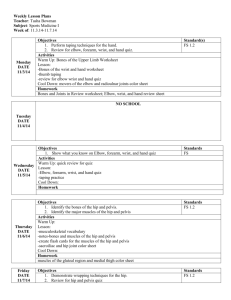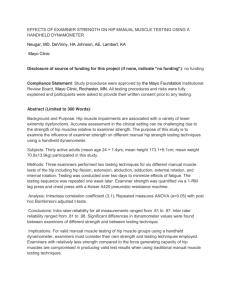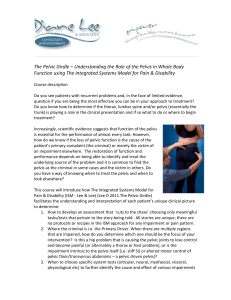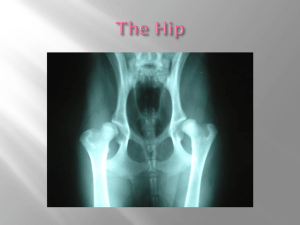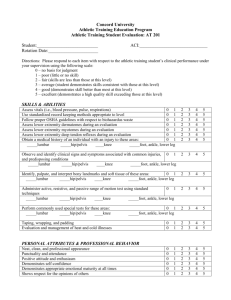effects of pelvis impact angle and hip muscle forces on hip fracture
advertisement
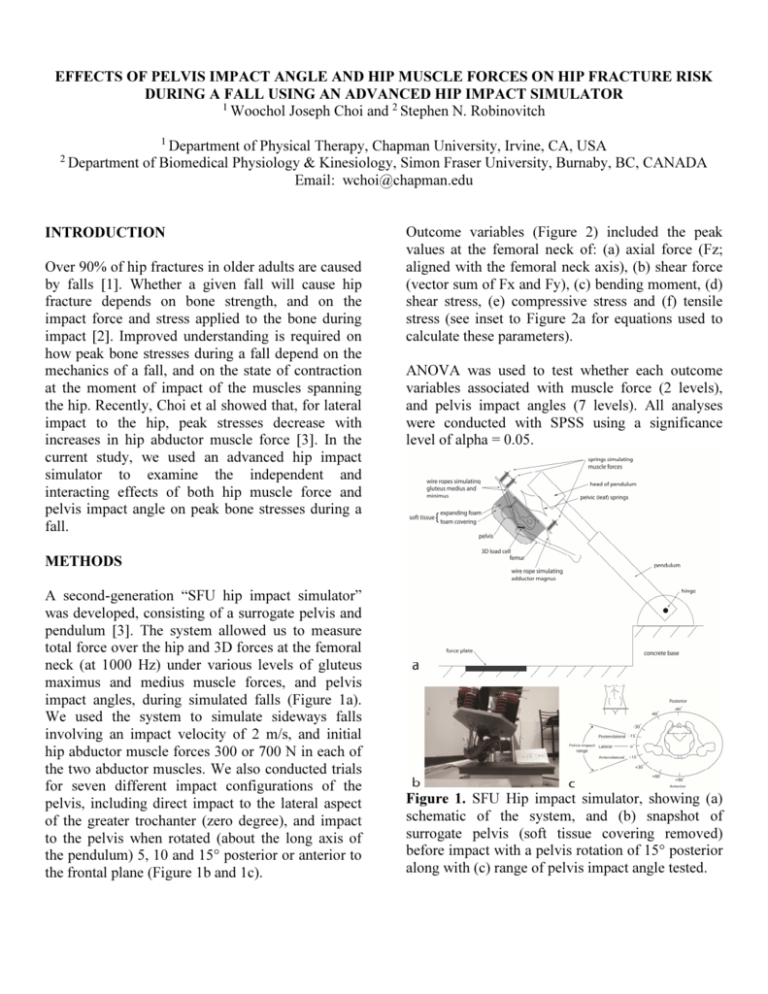
EFFECTS OF PELVIS IMPACT ANGLE AND HIP MUSCLE FORCES ON HIP FRACTURE RISK DURING A FALL USING AN ADVANCED HIP IMPACT SIMULATOR 1 Woochol Joseph Choi and 2 Stephen N. Robinovitch 1 2 Department of Physical Therapy, Chapman University, Irvine, CA, USA Department of Biomedical Physiology & Kinesiology, Simon Fraser University, Burnaby, BC, CANADA Email: wchoi@chapman.edu INTRODUCTION Over 90% of hip fractures in older adults are caused by falls [1]. Whether a given fall will cause hip fracture depends on bone strength, and on the impact force and stress applied to the bone during impact [2]. Improved understanding is required on how peak bone stresses during a fall depend on the mechanics of a fall, and on the state of contraction at the moment of impact of the muscles spanning the hip. Recently, Choi et al showed that, for lateral impact to the hip, peak stresses decrease with increases in hip abductor muscle force [3]. In the current study, we used an advanced hip impact simulator to examine the independent and interacting effects of both hip muscle force and pelvis impact angle on peak bone stresses during a fall. Outcome variables (Figure 2) included the peak values at the femoral neck of: (a) axial force (Fz; aligned with the femoral neck axis), (b) shear force (vector sum of Fx and Fy), (c) bending moment, (d) shear stress, (e) compressive stress and (f) tensile stress (see inset to Figure 2a for equations used to calculate these parameters). ANOVA was used to test whether each outcome variables associated with muscle force (2 levels), and pelvis impact angles (7 levels). All analyses were conducted with SPSS using a significance level of alpha = 0.05. METHODS A second-generation “SFU hip impact simulator” was developed, consisting of a surrogate pelvis and pendulum [3]. The system allowed us to measure total force over the hip and 3D forces at the femoral neck (at 1000 Hz) under various levels of gluteus maximus and medius muscle forces, and pelvis impact angles, during simulated falls (Figure 1a). We used the system to simulate sideways falls involving an impact velocity of 2 m/s, and initial hip abductor muscle forces 300 or 700 N in each of the two abductor muscles. We also conducted trials for seven different impact configurations of the pelvis, including direct impact to the lateral aspect of the greater trochanter (zero degree), and impact to the pelvis when rotated (about the long axis of the pendulum) 5, 10 and 15° posterior or anterior to the frontal plane (Figure 1b and 1c). Figure 1. SFU Hip impact simulator, showing (a) schematic of the system, and (b) snapshot of surrogate pelvis (soft tissue covering removed) before impact with a pelvis rotation of 15° posterior along with (c) range of pelvis impact angle tested. We also found that the hip abductor muscle force associated significantly with all of our outcome variables (p<0.018). Furthermore, there was a significant interaction between muscle force and pelvis impact angle for all outcome variables (p<0.02). Overall, peak tensile and compressive stresses were 25% lower and 5% greater, respectively, with 700 N than 300 N hip abductor muscle force. When the pelvis impact angle was zero, peak tensile and compressive stresses averaged 73% and 8% lower in the 700 N than 300 N muscle force condition. These results are similar to our previous findings for lateral impacts under a variety of knee boundary conditions [3]. RESULTS AND DISCUSSION We found that pelvis impact angle associated significantly with all of our outcome variables (p<0.0005), but had a more dramatic effect on peak tensile than peak compressive force (Table 1). On average, peak compressive and tensile stresses decreased 27% and 68%, respectively, when the pelvis impact angle changed from 15° posterior to 15° anterior. These results agree with previous findings from cadaveric studies and finite element modeling that posterolateral hip impact carries highest risk of hip fracture during a fall [4,5]. In general, increases in muscle force were protective (caused a reduction in bending moment, and peak compressive and tensile stress) at zero degree and anterior impact angles, and dangerous (caused an increase in bending moment and peak stresses) for posterior impact angles. This likely relates to the muscle force having a greater protective “tension band” effect when the impact force and muscle force are aligned to create moments about a similar axis. REFERENCES 1. Grisso JA et al., J Am Geri Soc 12, 1326-31, 1991 2. Bouxsein ML et al., JBMR 22, 825-31, 2007 3. Choi WJ et al., Osteoporos Int 26, 291-301, 2015 4. Keyak JH et al., J Orthop Res 19, 539-544, 2001 5. Pinilla TP et al., Calcif Tissue Int 58, 231-5,1996 Figure 2. Experimental measures and calculated outcome variables. (a) Free body diagram and stress analysis at the proximal femur at impact from a fall. (b) Sample force and stress traces for 300 N with zero degree of pelvis rotation (lateral impact). Table 1: Average values of outcome variables (with SD shown in parentheses). muscle force (N) pelvis impact angle (deg) -15 -10 -5 300 N lateral Zero peak axial force (N) 1418 (1) 1515 (175) 1850 (3) 2004 (15) 2138 (17) 2161 (32) 1899 (19) 1709 (96) 1906 (5) 2177 (16) 2228 (45) 2284 (16) 2314 (28) 2005 (163) peak shear force (N) 484 (1) 445 (75) 513 (2) 489 (13) 454 (3) 378 (9) 326 (17) 584 (29) 542 (13) 451 (9) 388 (23) 355 (46) 283 (9) 332 (13) peak bending moment (Nm) 13.1 (0.0) 12.0 (2.0) 13.8 (0.1) 13.2 (0.3) 12.2 (0.1) 10.2 (0.2) 8.8 (0.4) 15.8 (0.7) 14.6 (0.3) 12.1 (0.2) 10.5 (0.6) 9.6 (1.2) 7.7 (0.2) 9.0 (0.3) peak shear stress (MPa) 0.56 (0.00) 0.52 (0.08) 0.60 (0.00) 0.57 (0.01) 0.53 (0.00) 0.44 (0.01) 0.38 (0.02) 0.68 (0.02) 0.63 (0.01) 0.52 (0.01) 0.45 (0.02) 0.41 (0.05) 0.33 (0.01) 0.38 (0.01) peak compressive stress (MPa) 5.35 (0.01) 5.16 (0.80) 6.08 (0.01) 6.06 (0.09) 5.96 (0.02) 5.38 (0.08) 3.89 (0.14) 6.47 (0.29) 6.46 (0.03) 6.00 (0.05) 5.57 (0.23) 5.54 (0.08) 5.17 (0.05) 4.73 (0.22) peak tensile stress (MPa) 2.09 (0.01) 1.66 (0.33) 1.78 (0.01) 1.43 (0.10) 0.99 (0.03) 0.41 (0.04) 1.10 (0.11) 2.52 (0.10) 2.03 (0.05) 0.90 (0.09) 0.38 (0.14) 0.41 (0.09) 0.46 (0.02) 0.39 (0.06) posterior anterior -5 700 N lateral zero 5 10 15 posterior 5 10 15 -15 -10 anterior
